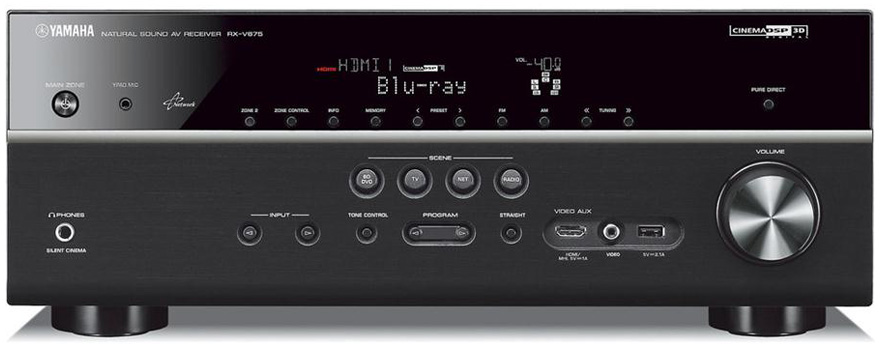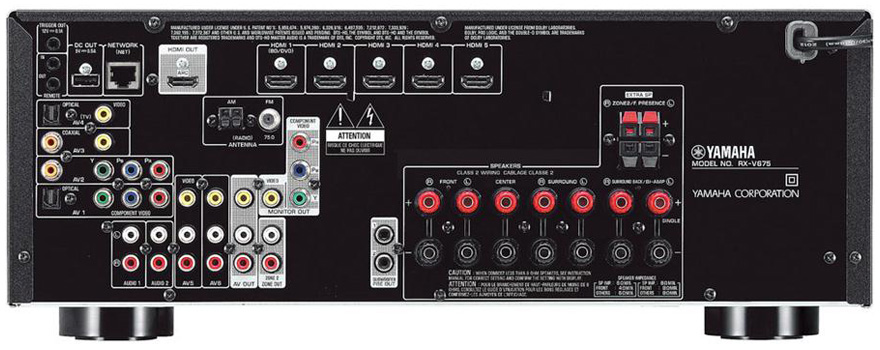Yamaha is not just a famous brand attached to musical instruments and motorcycles. It also happens to be a brand that dwells in people’s living rooms where home theater systems are setup. If you already have a small home theater system setup, you can give your home theater system plenty of room for growth if you go for a feature-packed home theater receiver. The Yamaha RX-V675 fits the bill nicely and costs less than $700. It succeeds the RX-V673 released back in 2012 but the RX-V675 can be viewed more as a refreshed model than anything else with the main addition being MHL support.
Design
The Yamaha RX-V675 looks virtually identical to its predecessor from the front. The size is the same as well as the choice of materials and the button layout. Most AV receivers that cost at least $600 normally have two knobs for controlling the volume and changing the input source respectively but the only knob present controls the volume. You have to press the input selector buttons to cycle through the sources. Fortunately, there are only a total of 6 HDMI inputs and 4 of them can be assigned to any of the 4 SCENE buttons on the front of the receiver.
One of the big pluses that the RX-V675 has over the cheaper models is the additional HDMI input on the front panel so any devices that can output video and audio through HDMI can easily be hooked up. But unlike the RX-V673 which also has a front panel HDMI input, you can also hook up any smartphones that rely on the new MHL standard which basically allows HDMI connectivity through the smartphone’s microUSB port using a special MHL cable. This cable can charge the device too so it is nice for the Yamaha RX-V675 to support this emerging standard. Going to the back of the receiver, the RX-V675 looks a little bit different than the RX-V673. However, there are no other serious additions or removals so what you see is just a redesigned layout.
Below is the back panel layout. Click on image to enlarge for a clearer view.
Features
The 7.2-channel specification already highlights how prepared the RX-V675 in handling an additional room. The RX-V575 has the necessary specifications as well but it has the limitation of handling a single audio source for both rooms. The Yamaha RX-V675 lifts that limitation which is great if you want to play a different playlist in the room with the 2.1-speaker configuration without interfering with the TV or Blu-ray playback going on in the main room. With Cinema DSP 3D support, the RX-V675 is also capable of decoding HD audio sources and optionally using a virtual presence speaker to provide a 3-D surround sound experience even if the system’s hardware doesn’t support 3-D surround sound.
Entry-level home theater receivers typically focus more on the audio experience but still have support for the latest technologies like 3D and 4K video resolutions. But the Yamaha RX-V675 is a little bit more advanced as it has a video upscaling technology that can boost the resolutions of lower quality sources to 1080p or even 4K if you connect a supported 4K display. It also has a technology called Edge Adaptive Deinterlacing which eliminates those jaggies present in diagonal lines by using an optimal pixel interpolation method.
The RX-V675 will only sound as good as the way you calibrate the speakers and the Yamaha RX-V675 eliminates that worry as it provides the best calibration possible regardless of the speaker setup through the YPAO Sound Optimization feature. This room calibration function is a bit more powerful than the YPAO Sound Optimization function present in cheaper Yamaha receivers. With Reflective Sound Control (RSC) implanted in this optimization process, early reflections can be corrected to achieve studio-like sound quality.
The RX-V675 can tap into your wireless router to allow wireless streaming. iPhone, iPod Touch and iPad devices get the best support as the receiver is AirPlay-compatible. It is as simple as choosing what song you want to play from your device and send it to the receiver complete with metadata. If you want a laptop or desktop to wirelessly stream too, you can use iTunes. Audio performance is very good and compressed audio files don’t seem to affect the overall audio quality. This is because the Compressed Music Enhancer works on the file during playback by restoring some of the lost data as a result to file compression. This receiver can also connect to online services in case you are a fan of Pandora or Rhapsody.
If you have an iOS or Android device, you can download the Yamaha AV Controller app for free so you can control the receiver in a more stylish fashion. The touchscreen interface is very user-friendly and it also works with Amazon’s Kindle Fire products.
To make use of the networking and Internet features, you have to get an Ethernet cable and connect the RX-V675 to the wireless router. While the Yamaha RX-V675 lacks its own built-in Wi-Fi support, you can purchase a separate adapter that plugs into the back so you can disregard the use of a messy wire to keep your entire home theater system connected. In fact, the value of network connectivity is even bigger if none of your other home theater components have the ability to join your home network. The RX-V675 can single-handedly push all new and old devices online even if they don’t have networking features. These components just have to constantly rely on the receiver for a stable connection. There is a network standby mode that keeps these networking features enabled and you can further use the ECO mode to further save electricity.
Bottom Line
The latest Blu-ray content play back wonderfully on the Yamaha RX-V675 and the video upscaling feature effectively brings new life to analog sources. While MHL is the new feature that should attract more Android users, the real selling points include video upscaling and full Zone 2 support. If you are specifically looking for those features, the RX-V675 is as affordable as you can possibly get.


